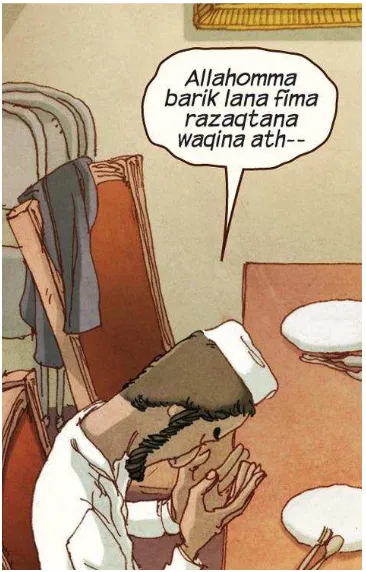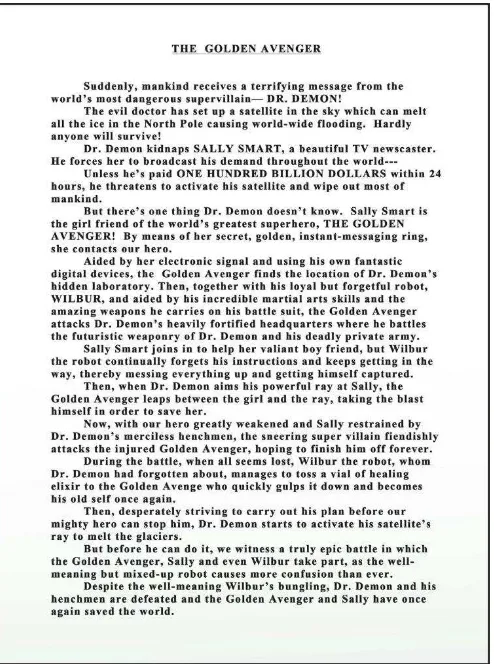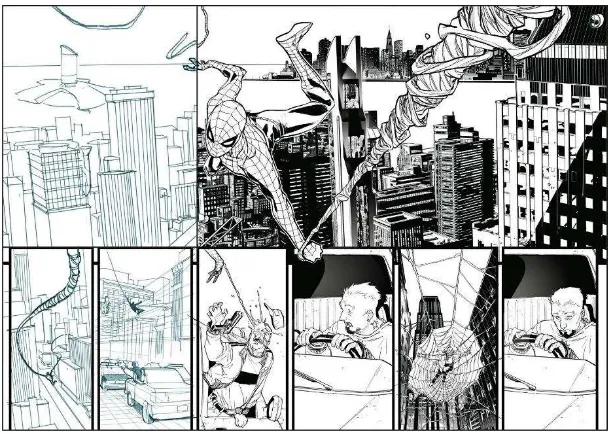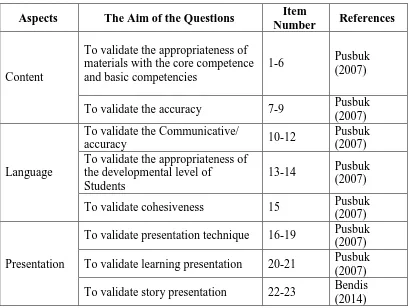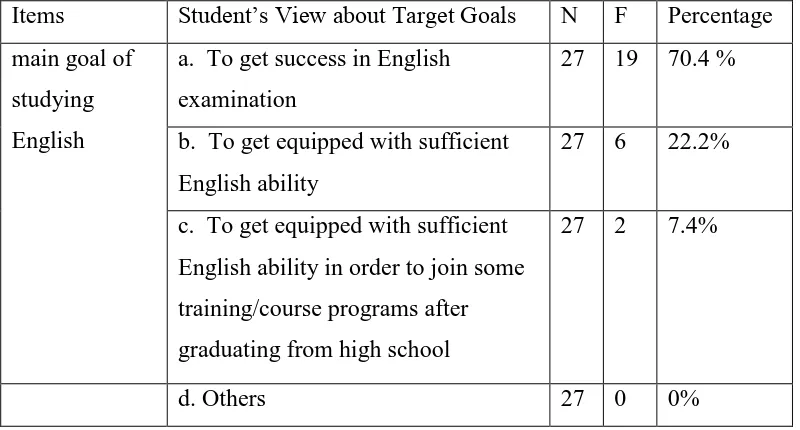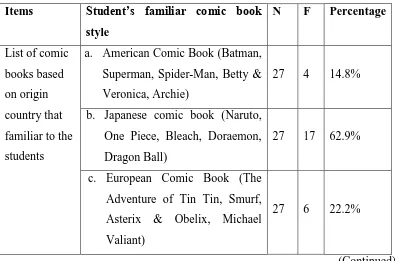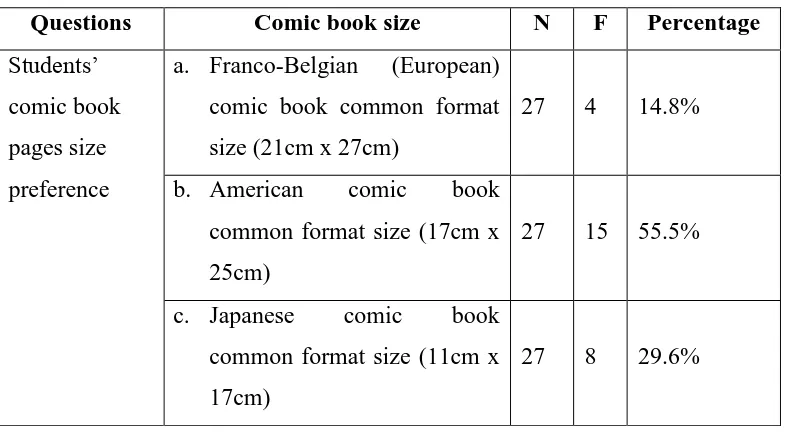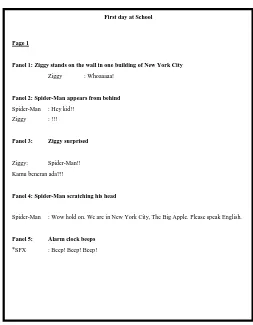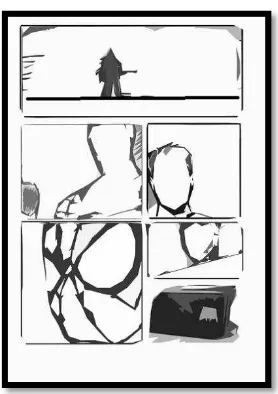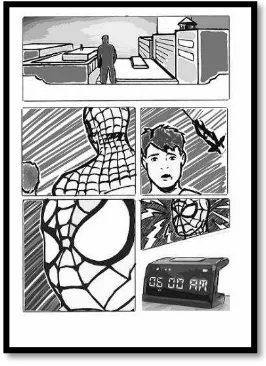i
DESIGNING A COMIC BOOK FOR EXTENSIVE
READING MATERIAL FOR 8
thGRADE STUDENTS
OF SMP N 2 SANDEN
A Thesis
Submitted as Partial Fulfillment of the Requirements for the Attainment of the Degree of Sarjana Pendidikan in English Language Education
Deny Gustaf P
NIM 08202244044
STUDY PROGRAM OF ENGLISH EDUCATION FACULTY OF LANGUAGES AND ARTS
STATE UNIVERSITY OF YOGYAKARTA
iv
MOTTOS
The Amazing Spider-Man Special: Inhuman Error
vi
ACKNOWLEGEMENTS
All the praise be to God, the One-Above-All Who has blessed me with beautiful things in my life and “Deus Ex Machina” in my hopeless situations. I would like to express my sincere gratitude to the following good associates.
1. Bapak Joko Priyana, Ph.D. and Bapak Ari Purnawan, M.A., for their inspiration, enthusiasm, and support. I could not have imagined having better supervisors for my thesis journey.
2. Ibuk, Ayah, Simbah for their support, care, prayer, and endless love.
3. My second family Om Timur, Tante Lita, Dea, and Tirza for unstoppable support.
4. My Big Brother figures, Yuga Adwidya, Lord Agung John for taught me how to be a real man.
5. My Mythos Circle: The third supervisor, ibu Amy Firstyani, for more specific, efficient thesis guidance, Adit, for the cynical critic and support. Anggita, for the Sinner-Chicken-Noodle academic talk , Pangestu, for showing me how to do things thug’s way, Damar, Nila, Ichak, Juri, and The Splendid, knowing, capable, dag, fragile Mutia for everything happened in the Fury Road
6. The Illuminati of Marvel Enthusiast YK (Marvel Piyungan): Himawan, Kidjing, Yayok, and Ahong for very anti-mainstream geek discussions we had.
viii
DEDICATIONS
I DEDICATE THIS THESIS TO:
My 13 years-old-self
for giving me the
inspiration to start this project
and
My future-Self
for giving me the
ix
TABEL OF CONTENTS
TITLE PAGE ... i
APPROVAL SHEET ... ii
RATIFICATION SHEET ... iii
MOTTOS ... iv
DECLARATION ... v
ACKNOWLEDGEMENTS ... vi
DEDICATIONS... viii
TABLE OF CONTENTS ... ix
LIST OF FIGURES ... xii
LIST OF TABLES ... xiii
LIST OF APPENDICES ... xv
ABSTRACT ... xvi
CHAPTER I INTRODUCTION A. Background of the Study ... 1
B. Identification of the Problem ... 2
C. Limitation of the Problem ... 3
D. Problem Formulation ... 4
E. The Objective of the Study ... 4
x
CHAPTER II LITERATURE REVIEW, RELEVANT STUDIES, AND CONCEPTUAL FRAMEWORK
A. Literature review ... 6
1. The Characteristics of the 8th Grade Junior High School Students .... 6
2. The Nature of Reading ... 7
3. Extensive Reading ... 8
4. Material Development ... 10
5. Comics ... 11
a. Definition of Comic ... 11
b. Components of Comic ... 12
c. Making Comic Steps ... 16
d. The Strength of Comic in Education ... 19
B. Review of Related Studies ... 21
C. Conceptual Framework ... 22
CHAPTER III RESEARCH METHOD A.Type of Research ... 24
B.Subject of the Research ... 24
C.Research Setting ... 24
D.Procedure of the Research ... 25
E. Research Instrument ... 27
F. Data Collection Techniques ... 30
CHAPTER IV RESEARCH FINDINGS DISCUSSION A. Research Findings ... 33
The Result of Needs Analysis ... 33
a. Description of the Learners ... 33
b. Target Needs ... 33
c. Learning Needs ... 35
xi
1. Writing the Story Outline and Dialogue ... 46
2. Drawing The Comic Story Board ... 48
3. Drawing The Comic Illustrations ... 49
4. Lettering ... 50
5. Making the Exercise Page ... 51
D. The Expert Judgment ... 52
1. The Results of Expert Judgment Related to the Content of Each Chapter ... 53
a. Results of Expert Judgment and Revisions of chapter 1 ... 53
b. Results of Expert Judgment and Revisions of chapter 2 ... 57
c. Results of Expert Judgment and Revisions of chapter 3 ... 60
d. Results of Expert Judgment and Revisions of chapter 4 ... 63
2. The Result of Expert Judgment Related to Comic Book Form in General ... 67
a. Art Illustration ... 67
b. Paneling ... 68
c. Lettering ... 68
E. Discussions ... 69
CHAPTER V CONCLUSIONS, IMPLICATIONS, AND SUGGESTIONS A. Conclusions ... 72
B. Suggestions ... 75
REFERENCES ... 76
xii
LIST OF FIGURES
FIGURE 1. EXAMPLE OF CLOSED PANEL. THE ADVENTURES OF TINTIN: THE
SECRET OF THE UNICORN (FRENCH: LE SECRET DE LA LICORNE) BY
HERGE (1946) ... 13
FIGURE 2. EXAMPLE OF OPEN PANELS. TAKEN FROM BATMAN-SUPERMAN #1 ART BY JAE LEE (2013) ... 13
FIGURE 3. EXAMPLE OF WORDS BALLOON, TAKEN FROM MS MARVEL #1 WRITTEN BY G. WILLOW WILSON (2013) ... 14
FIGURE 4. EXAMPLE OF NARRATION, TAKEN FROM BATMAN-SUPERMAN #1 WRITTEN BY GREG PAK (2013) ... 15
FIGURE 5.EXAMPLE OF SOUND EFFECT. TAKEN FROM SPIDER-MAN BLUE. WRITTEN BY JEPH LOEB ART BY TIM SALE (2002) ... 15
FIGURE 6. THE SCRIPT OF THE GOLDEN AVENGER (1963) WRITTEN BY STAN LEE . 17 FIGURE 7. PANELS FROM ALL-NEW SPIDER-MAN (2012) ART BY SARA PICHELLI ... 18
FIGURE 8. ONE OF THE COMIC SCRIPTS PAGE ... 48
FIGURE 9.ONE OF THE COMIC STORYBOARDS ... 49
FIGURE 10. COMIC ILLUSTRATING PROCESS ... 50
FIGURE 11. COMIC FINAL ILLUSTRATION ... 50
FIGURE 12. LETTERING PROCESS USING COMIC LIFE 3 SOFT WARE ... 51
FIGURE 13. LETTERING PROCESS ... 51
xiii
LIST OF TABLES
TABLE 1. THE ORGANIZATION OF THE QUESTIONNAIRE ... 27
TABLE 2. THE ORGANIZATION OF THE SECOND QUESTIONNAIRE ... 29
TABLE 3. THE ORGANIZATION OF THE THIRD QUESTIONNAIRE ... 29
TABLE 4. DATA CONVERSION TABLE (SUHARTO, 2006: 52 - 53) ... 31
TABLE 5. DATA OF RESPONDENTS FROM THE 8-C STUDENTS OF SMP 2 SANDEN BANTUL ... 32
TABLE 6. THE STUDENT’S VIEW ABOUT TARGET GOALS ... 33
TABLE 7. STUDENTS’ DIFFICULTIES IN LEARNING ENGLISH ... 34
TABLE 8. STUDENTS’ WANTS IN LEARNING ENGLISH ... 35
TABLE 9. STUDENTS’ FAMILIAR COMIC BOOK STYLE ... 36
TABLE 10. STUDENT’S FAVORITE STORY THEME ... 37
TABLE 11. COMIC BOOK MAIN CHARACTERS ... 38
TABLE 12. STORY SETTING ... 39
TABLE 13. COMIC BOOK SIZE... 40
TABLE 14. FONT CHOICE ... 41
TABLE 15. FREQUENCY OF PANEL PER PAGE... 41
TABLE 16. STUDENTS’ FREQUENCY IN READING COMICS IN GENERAL ... 42
TABLE 17. STUDENT’S EXPERIENCE IN READING ENGLISH COMIC BOOK ... 43
TABLE 18. THE APPROPRIATENESS OF THE CONTENT OF CHAPTER 1 ... 53
TABLE 19. THE APPROPRIATENESS OF LANGUAGE OF CHAPTER 1 ... 55
TABLE 20. . THE APPROPRIATENESS OF THE PRESENTATION OF COMIC OF CHAPTER 1 ... 56
TABLE 21. THE APPROPRIATENESS OF THE CONTENT OF CHAPTER 2 ... 57
xiv
TABLE 23. THE APPROPRIATENESS OF THE PRESENTATION OF COMIC OF CHAPTER
2 ... 59
TABLE 24. THE APPROPRIATENESS OF THE CONTENT OF CHAPTER 3 ... 61
TABLE 25.THE APPROPRIATENESS OF THE PRESENTATION OF COMIC OF CHAPTER 3 ... 62
TABLE 26. THE APPROPRIATENESS OF THE CONTENT OF CHAPTER 4 ... 63
TABLE 27. THE APPROPRIATENESS OF THE LANGUAGE OF CHAPTER 4 ... 65
TABLE 28. THE APPROPRIATENESS OF THE PRESENTATION OF COMIC OF CHAPTER 4 ... 66
TABLE 29. THE APPROPRIATENESS OF COMIC ILLUSTRATION IN GENERAL ... 67
TABLE 30.THE APPROPRIATENESS OF COMIC PANELING IN GENERAL ... 68
xv
LIST OF APPENDICES
Apendix A Needs Analysis Questioner ... 81
Apendix B The Result of Needs Analysis ... 82
Apendix C Syllabus ... 92
Apendix D First Draft of the Material ... 95
Apendix E Expert Judgment Questioner ... 149
Apendix F Result of Expert Judgment ... 171
xvi
DESIGNING A COMIC BOOK FOR EXTENSIVE READING MATERIAL FOR 8th GRADE STUDENTS OF SMP N 2 SANDEN
Deny Gustaf Pesonatama
08202244044
ABSTRACT
The aims of this research were: (1) to find the target needs of the students, (2) to find learning needs of the students, and (3) to design an appropriate comic book for based extensive reading material for 8th grade students of SMP N 2 Sanden.
This research was a research and development (R & D) study. The subjects of the research were the students of VIII C of SMP N 2 Sanden 2013/2014. This research was conducted with some adjustment. The first step was a needs analysis done by distributing questionnaire to the students, and the result of the need analysis was the basis for developing a syllabus. The syllabus was used as the guideline to develop the first draft of the learning materials. The first draft was evaluated by material evaluators by distributing the second questionnaire. The result of the evaluation was analyzed through descriptive statistics and used for
second chapter tells about the Ziggy’s writing task about the experiences when he
visited Central Park Zoo. The third chapter is Cooking Demonstration. It is a procedure video demonstration about cooking simple pancakes. The last chapter is entitled Space Oddity. This is a visualization of a song lyric entitle Space Oddity narrated as Ziggy’s dream. There are some tasks at the end of each chapter. The
1
CHAPTER I
INTRODUCTION
A. Background of the Study
SMP N 2 Sanden, Bantul, Yogyakarta is located in Srigading Sanden Bantul which has more than 640 students. SMP N 2 Sanden, Bantul has 24 classes, each class has eight parallel classes (A, B, C, D, E, F, G, H). There is a library in this school which provides English text books and English dictionaries collections.
In their English learning process, students of SMP N 2 Sanden only rely on their textbook and LKS (lembar Kerja Siswa). Whereas the government has finally decided to try out the new designed curriculum, the 2013 curriculum. The
2013 curriculum requires students to learn their school subjects not only from the intensive text books and LKS provided by their school teacher but also from any other sources and media around them.
The other sources of media for students to learn English are various. They
could be newspapers fully written in English, or some English articles on the
internet which are more accessible. The students’ sources of entertainment can
also be potential sources for them to gain their English skills, for example: Comic
Comic Book is one of the oldest entertainment media that successfully
attracts children and teenagers. For decades comic books have been something
believed as the moral destructor for children and teenager, but now by the change
of paradigm of education, comic books can be transformed into learning media
that have force in the development of literacy, especially for teenagers.
Furthermore, because of the format of comic is a combination of images and texts,
comics can attract teenagers’ attention longer than other general reading materials.
Children and teenagers in Indonesia read Japanese comic books which are
also known as “Manga.” Almost all comic books published in Indonesia are
translated manga. Unlike the US comic book, manga has more variety of genres including drama, romance, fantasy, adventure, and even sports. Those varieties Manga genres make it more attractive to Indonesian children, both male and female.
In line with this, the present study is an attempt to design a comic book for extensive reading material. It is expected that the outcome of this study will be beneficial for students.
B. Identification of the Problem
Based on the background of the problem, there are some occurring
problems related to the selection appropriate media to support students’ language
learning. Those problems are the lack of learning sources.
flashcards, and authentic materials, etc. that attract the students’ attention. It made the students easily get tired, bored, and not motivated in learning English. The upcoming Curriculum 2013 also required students to actively find other sources of learning.
The lack of appropriate media to support teaching reading is possibly caused by the teacher dependency to text books and LKS. This situation made the teaching and learning process not effective. Moreover, in teaching reading, the instructional media have important role in the class.
Comic book could be the answer to the lack of appropriate media to support teaching reading, but it is rarely been found a comic book which is
designed solely to enhance Indonesian children’s reading motivation and reading
skill. Based on the observation, there is already an English educational comic book for 7th grade students published by Directorate of Junior High School of Indonesia. The Comic book is not so popular among the students. The comic was not graphically drawn well, the paneling is placed orthodoxly, besides the story of is too common which tells a daily life with no variation. Since the teaching of reading requires reading sources that support the activities, appropriate and attractive reading material such as comic books are needed.
C. Limitation Problem
D. Problem Formulation
Based on the discussion on the research background, problem identification, and limitation on the problem, the formulation of the problem can be stated as follows.
1. What are the English learners’ needs and learning needs of 8th grade students of SMP N 2 Sanden?
2. What are the appropriate comic book for extensive reading material for 8th grade students SMP N 2 Sanden?
E. Objective of the Study
Based on the formulation of the problems, the objectives of this study are presented below:
1. Finding the target needs and learning needs of 8th grade students of SMP N 2 Sanden.
2. Designing an appropriate comic book for extensive reading material for 8th grade students of SMP N 2 Sanden
F. Significance of Research
This research is expected to provide some contribution as follows:
2. For the English teachers of of SMP N 2 Sanden, it would help them in providing reading material for students, both inside and outside the classroom
3. For the Headmaster of SMP N 2 Sanden, it would be a beginning step to do the
efforts in enriching students’ comprehension of English lesson.
4. For English material designers, this research can be used as a reference to
develop other materials that are appropriate with learners’ needs.
6
CHAPTER II
LITERATURE REVIEW AND CONCEPTUAL FRAMEWORK
A. LITERATURE REVIEW
1. The Characteristics of The 8th Grade Junior High School Students
The 8th Grade Junior High School students commonly are in the range of age between 13-14 years old. Based on their age 8th Grade students can be categorized as teenagers. They belong to adolescent learners. In this period, teenagers are most likely love to spend time for hanging around, and often disruptive behavior in class. However, they may have great capacity in learning if the teacher can engage them by the things that trigger their curiosity. The characteristics of adolescent learners according to Harmer (2001:38) are:
a. They seem to be less lively and humorous than adults.
b. Identity has to be forged among classmates and friends; peer approval may be considerably more important for the student than the attention of the teacher.
c. They would be much happier if such problem did not exist. d. They may be disruptive in class.
e. They have a great potential creativity, and a passionate commitment to things that interest them.
with opportunities to explore and experiment in a stable and supportive
atmosphere. The teacher’s job is to provoke intellectual activity by helping them
to be aware of contrasting ideas and concepts, which they can resolve by
themselves though the teacher’s guidance is still needed.
2. The Nature of Reading
There are many definitions of reading delivered by different experts. Carrel (1993:12) points out that reading is a receptive language process. The writer encodes his thought as a language and readers decodes the language by interpreting the written symbols. This definition illustrates that in reading, the writer conveys their ideas via language he encrypted and the reader decrypted the
language to understand the writer’s idea
Reading is a complex and interactive process. Celce–Murcia (2001:154) states that reading involves a text, a reader and social context in which reading takes place. In reading, meaning is constructed trough the interpretation of written symbol that represent language. This interpretation influenced by the reader
experiences, language background, reader’s culture, as well as the reader’s
purpose of reading
Furthermore, Johnson and Mikulecky (1990:2) define reading as more than an interaction between the reader and the text. They define reading as complex behavior that involves conscious and unconscious use of various strategies to build the meaning which writer intended.
Based on those definitions above, it can be concluded that reading is an
active cognitive activity of getting writer’s idea through interpreting the written
symbols. In the process of reading, the reader is affected by his/her experience, language background, cultural background, and purpose for reading.
3. Extensive Reading
Harris and Sipay (1990:655) point out that extensive reading is an approach to the teaching and learning language, where the learners read a large number of books and any other material that within their linguistic competences. They added that extensive reading needs superior materials, teachers who love to read themselves, time, and effort to develop their reading habit.
Furthermore, Day and Bamford (1998:7) states that extensive reading has some characteristics:
1. Students read as much as possible, both inside and outside the classroom. 2. Materials on a wide range of topics is available to encourage reading for
different reasons and ways.
4. The purposes of reading are for pleasure, find information, and general
understanding, these purposes are determined by students’ interest and
the nature of the materials.
5. Reading is its own reward. It means after the reading process is finished there will be little or no exercise.
6. The reading materials are within the students’ linguistic competence level in terms of vocabulary and grammar. Here, dictionaries are rarely used while reading to enhance fluent reading.
7. Reading is individual and silent.
8. Reading speed is usually faster when students read books of materials they find easy to understand.
9. Teachers give orientation of the goals of the extensive reading program to the students. Keep track of what each student reads, and guide them in getting the program
10.The Teacher is the role model of a reader for students.
Based on those definition above, it can be conclude that extensive reading is an approach to the teaching and learning language by asking the student to rapidly read books they want as much as posibble. The purposes of extensive reading are for pleasure, find information, and general understanding, the
4. Materials Development
Materials are defined as anything which is used by the teachers and learners to facilitate the learning of a language. Materials development refers to anything which is done by writers, teachers or learners to provide sources of language input and to exploit those sources in ways which maximize the likelihood of intake (Tomlinson, 1998: 2)
Moreover, Tomlinson (1998:7-21) proposes eight principles that are relevant to the development of materials for language teaching, as follows:
1) Materials should achieve impact;
2) Materials should help learners to feel at ease;
3) Materials should help the learners to develop confidence;
4) What is being taught should be perceived by learners as relevant and useful;
5) Materials should require and facilitate learners’ self-investment; 6) Materials should expose the learners to language in authentic use;
7) Materials should provide the learners with the opportunity to use the target language;
should reflect the learners needs, therefore the material developer has to know what students needs first.
5. Comics
a. Definition of Comic
The precise definition of comic is still remains a subject of debate among some scholars. They insist that comic’s printed nature is crucial to the definition, or that they should be defined by the interdependence of images and texts. The godfather of comic, Will Eisner (1985) frequently referring comic by a simple
terms “squential art” it contains both art and literary form. Eisner stated that comic or sequential art is a distinct discipline that deals with the arrangement of pictures and images to narrate story or dramatize ideas.
Meanwhile, cccording to Scott McCloud in his book Understanding Comic (1993:9), comics are juxtaposed pictorial and other images in deliberate sequence, intended to convey information and/or to produce an aesthetic response in the viewer. By this definition, single panelled illustrations cannot be defined as comics, but defined as cartoon.
represented by pictorialand linguistic images encapsulated in a sequence of
juxtaposed panelsand pages.
Based on those definition above, it can be concluded that comics is an art form using a series of static images in fixed sequence, written text is often incorporated. The three most common forms of comics are comic strips (as appear in newspaper), comic books (also popularly called “manga” when referring to Japanese comic books) and Graphic Novels. Comic strips are serial comics that are published in a newspaper. Whereas comic books are weekly or monthly magazine containing purely stories that served in comic form. The last form is Graphic novel. Comic books sometime come using a different term, graphic
novel, to describe the more ambitious works in the art form. For creators, labeling
their work a graphic novel allows them to distance themselves from the
commercial and periodical connotations associated with comic books.
b. Components of Comic
According to McCloud (2003) comic has several fundamental components: Panel, Gutter or ditch, word balloon, narration, and effect
1) Panel
The panel is a field limit part on the comic page. There are two kinds of panel, closed panel and open panel.
Figure 1. Example of Closed Panel. The Adventures of Tintin: The Secret of the Unicorn (French: Le Secret de la Licorne) by Herge (1946)
b) Open panel is panel without borders surround it. This panel variant is commonly used in recent comic book.
2) Gutter or Ditch
Gutter is a blank space or distance that exists among panels in the comic page. Gutter will rarely be found in comic book which use mostly open panels
3) Words Balloon
Words balloon is a space that contain direct speech uttered by the comic book
character. It shows that a character is speaking and this makes the reader’s
involvement in the story much deeper. The balloons may report speech or thought. The tail of the balloon indicates which character is speaking or thinking.
4) Narration
Narration is the description that mostly located in the corner of the panel to help the reader understand the scene or storyline.
Figure 4. Example of narration, taken from Batman-Superman #1 written by Greg Pak (2013)
5) Effect
Effect or sound effect in comic is letters or words that phonetically imitates the source of the sound that it describes. Sound effect is written outside the word balloon.
Figure 5.Example of Sound Effect. Taken from Spider-Man Blue. Written by Jeph Loeb art by Tim Sale (2002)
Each component has its own function in mixing written dialogue and a series of pictures into a comic book.
c. Making Comic Steps
The steps of making comic book according to Bendis (2014) can be explained as follows.
1) The Story Outline
The First step in making comic is creating the story outline. Comic outline is a quick one or two paragraph document that describes the story or series the writer is trying to tell. A comic story outline is involved document that goes into more detail about story and character arcs. The writer are basically writing a book report for a book that does not exist, a synopsis of something that is only in
writer’s head.
2) The Script
Figure 6. The script of The Golden Avenger (1963) written by Stan Lee
A Marvel Style script can provide a very freeing and creative experience for the artists, as they is in charge of so much visual depiction.
3) The Art
comic book artist is working the art digitally using computer program like Photoshop or Corel Painting, it can be said that there is no physical artwork.
Figure 7. Panels from All-New Spider-Man (2012) art by Sara Pichelli
4) Merging The Arts and Writings
Soon after the art are finished, the artist sends the art back to the writer to be examined accordingly.
5) Lettering
Based on the steps above, it can be concluded that making comic processes are commonly done by a team consist of more than two persons. Each step in making comic are handled by the professionals in particular fields such as writer, artist/penciler, and letterer.
d. The Strength of Comic in Education
Benefits or strength of comics in education according to Gene Yang (2003) can be described as follows:
1. Motivating
The most frequently mentioned asset of comics, as an educational tool, is its ability to motivate students. Through comic, the teacher can give motivation to the students to learn English in more enjoyable and interesting ways.
Comics motivate the students by their pictures. The use of colors, the name of animals, and the identification of the main parts of human body can be studied and understood fast with the use of cartoon comics. Sones (in Gene Yang 2003) theorizes that pictures tell any story more effectively than words.
2. Visual
Comics, being composed of pictorial and other images, are a
fundamentally visual medium. The interest of students in comics’ picture
emphasizes the potential of visual medium. In a study comparing comics to text,
second only text. Afterwards, each group was given a test on the content of the story. The result was the first group scored significantly higher than the second group. At the end, Sones concluded that a strong trend in favor of the picture continuity was indicated by two sets of results.
3. Intermediary
Comics can serve as an intermediate step to difficult disciplines and concepts. Many language and art educators have used comics in this manner with tremendous success. Karl Koenke (in Gene Yang 2003) suggests that comics can lead students toward the discipline of learning. Hutchinson’s experiment found out that many teachers discovered comic to be particularly useful in special classes or for slow learning pupils in regular classes.
Versaci (in Gene Yang 2003) found out that discussions on comics are generally livelier than those on classic novels. Through comics, Versaci encourages his students to think critically about the literary worth of books and the formation of the literary canon.
4. Popular
According to Versaci (in Gene Yang 2003), through comic books, teacher
can lead their students in a study of “contemporary lifestyle, myths, and values”.
Comic has been spread out widely as the medium to entertain. The colored illustration, simple theme and plot, and the characterization will attract the person who reads it. Amazingly, nearly everyone says “yes” if they are asked whether they have read comic. The wide spread of comic has interested the writer in using comic as a medium for teaching.
A teacher may use the potential of comic in motivating the students. The
main role of comic book in teaching is its strength in motivating the students’
interest. It is better to combine the use of comic with a particular method of teaching. Therefore, the use of comic as a medium of teaching will be more effective. A teacher should help the students to find a good and enjoyable comic
which is appropriate to the way the students think and the students’ age. In
addition, a teacher should help them get broader information and knowledge from the comic.
B. Review of Related Studies
There are several related studies which can show the effective use of comic for enrichment. The first one is the study done by Liu (2004). In this study
Liu investigated the effects of comic strips in second language learners’ reading
comprehension. From the study, it is found that among the genres (visual) comic
popular, accessible, and readable, and they combine aesthetic perception with intellectual pursuit.
Other studies about comic are also done by Muniran and Yusof (2008) and Tiemensma (2009). In their study, Muniran and Yusof gave more attention to the use of comics and graphic novels in school and libraries to promote literacies. From this study, it is found that the early perception that comics was nothing more than just cheap entertainment has changed. This media then has much more potentials in helping and contributing towards reading literacy among students in different stages of education. On the other hand, Tiemensma investigated the visual literacy, on the effort of promoting literacy through the use of comics as well. From this study, it is found that comics can motivate reluctant readers, engage children in reading, develop the comprehension and language skills of second-language learners, and teach visual literacy.
C. Conceptual Framework
To build students’ interest and motivation in learning English, the English
teacher should use interesting, fun and appropriate media in teaching and learning process in classroom. Csabay (2007) stated that comic is one of media which can
help students deal with both written and spoken language. The comic characters’
facial expressions inspire students to interpret their thought based on the expression and the story in comic provides the student with something to narrate
or describe. Comic is one medium which can arose the students’ motivation in the
Many researchers and teachers agree that motivation is crucial in language teaching. According to Csabay (2006: 24) comic is not only can be used to amuse
and to attract students’ interest but also it can be used as media in education. The
use of comic strip in language class gives some positive effects for students. According to McCloud (1993), there are some positive effects of comic in teaching language. The first is comic provide image of the character, so they can help the students to deal with spoken and even informal language. Second, comic
can increase student’s motivation to learn English in enjoyable and interesting ways. The third is comics can motivate the students by their pictures. The last, comics are visual. It contains many visual symbols which have the power to present concrete realities. They are very impressive and interesting so that the
information presented by comics will stay longer in the student’s mind.
24
CHAPTER III
RESEARCH METHOD
A. Type of Research
As the purpose of this study is to design a comic book for extensive reading material, this research is classified as Research and Development (R & D). Borg and Gall (1983: 772) define the term R & D as a process used to develop and validate educational products used in the field by following the
methodological steps. The term “Educational Products” may refer to materials
any, such as books, pictures, screenplay, video, enrichment materials, supplementary materials, task books,videos, softwares, etc.
The educational product result of this research is a comic book for enrichment for the 8 grade students of SMP 2 Sanden Bantul. The comic book is not completely an educational product but also follows the steps of making comic suggested by Bendis (2014).
B. Setting
The research study was conducted in late November 2013 at SMP 2 Sanden. The School is located in Srigading Sanden Bantul Yogyakarta.
C. Research Subject
because according to some teachers the class has interest in visual object, and some students are readers of Japanese comics.
D. Research Procedures
As this research study was categorized into R & D, the research procedure followed the R & D cycle proposed by Borg and Gall (1983: 775) with some adaptation to meet the conditions of the research. The research procedures were describes as follows:
1. Conducting The Needs Analysis
Conducting a needs analysis was the first step in doing this research.
This step was used to obtain the information on the learners’ English proficiency, the learners’ habit on reading comic, intrinsic elements of comics,
and learning needs in learning English. The information was gathered in the previous step before writing the screenplay dialogue and the chapter design.
The learners’ needs in terms of necessities were analyzed for design a comic
book for extensive reading material for 8 grade students.
2. Writing the Syllabus
The results of the need analysis questionnaire were used to write the syllabus and story outline. The syllabus consists of Standard of Competence and Basic Competencies of 2013 Curriculum.
comic book and storyboard explains the details in pictures. The content of the screenplay was following the curriculum years of 2013 for 8 grade students,
but the theme and the story were based on students’ interest. It includes
elements of comics, and learning needs in learning English.
3. Designing The Material
From the syllabus, the stories were transformed into a comic book. There are four story chapters in the comic book that implicitly apply the basic competencies of 2013 curriculum for 8th grade students. The first chapter
entitled “first day at new school” which is introducing the main character of the comic. The second chapter is a combination between an experience recount
story and animals’ description entitled “The School Trip”. The third chapter is a story of procedure entitled “Cooking Demonstration”. The last chapter is a
visual narration of a song by David Bowie. The title of the chapter is Space Oddity, named after the original title of the song.
4. Materials Evaluation (Expert judgment)
The evaluation questionnaire covers the content evaluation, presentation evaluation, language evaluation and graphic evaluation. The questionnaire point is developed based on Likert-Scale questionnaire with four-point range.
5. Writing the Final Draft of the Materials
The final draft was developed based on the result of the evaluation questionnaire. The final draft is considered as the final product of this research.
E. Research Instruments
The data collected in this research are obtained through questionnaires. There are two types of questionnaires used in this research. The needs analysis was conducted in December 2013. The data were collected using questionnaires. The questionnaire contains several questions, including the level of the student,
students’ experiences to comic book, intrinsic element in comic book that they
want, and what they expect to learn from the comic book. The questionnaire’s organization is presented in the following table:
Table 1. The Organization of the Questionnaire
(Continued) whether it is an American comic book, European, Japanese, or 6 To find out what main character
the students most interested.
McCloud (2007) 7 To find out what location setting
the students most interested
11 To find how often the students reading comic books.
McCloud (2007) 12 To find out student experience
with full English comic book.
McCloud (2007)
given to a material expert while the second questionnaire is given to comic illustration expert.
Table 2. The Organization of the Second Questionnaire
Aspects The Aim of the Questions Item
Number References
Content
To validate the appropriateness of materials with the core competence and basic competencies
1-6 Pusbuk
(2007)
To validate the accuracy 7-9 Pusbuk (2007) To validate the appropriateness of
the developmental level of Students
13-14 Pusbuk (2007) To validate cohesiveness 15 Pusbuk
(2007)
Presentation
To validate presentation technique 16-19 Pusbuk (2007) To validate learning presentation 20-21 Pusbuk
(2007) To validate story presentation 22-23 Bendis
(2014)
Table 3. The Organization of the Third Questionnaire
Aspects The Aim of the Questions Item
(Continued)
Aspects The Aim of the Questions Item
Number References
Paneling To validate panel dynamism. 6,7. McCloud (2007) To validate gutter proportion. 8. McCloud
(2007) Lettering To validate words balloon
function/choice and placing.
9,10,11 McCloud (2007) To validate fonts choice 12,13 McCloud
(2007) To validate sound effects choice 14,15. McCloud
(2007)
F. Data Collection Technique
a. First questionnaire (Needs Analysis)
Data from Needs Analysis questionnaire was analyzed through calculating the percentage of each answer on the questionnaire by following this formula:
Percentage (%) = f/N (100)
The highest percentage of answers for each question is considered as the tendency of the students related to the condition.
b. The second questionnaire (Expert Judgment)
analyzed by using the formula proposed by Suharto (2008: 14) as follows.
In classifying the category of mean, theory proposed by Suharto (2006) about quantitative data conversion was used
Then, the data resulted were converted to descriptive analysis in terms of its goodness as proposed by Suharto (2006: 52 - 53).
Table 4. Data Conversion Table (Suharto, 2006: 52 - 53)
Scales Interval Categories
4 3.25 ≤ X ≤ 4.00 Very Good 3 2.25 ≤ X ≤ 3.24 Good 2 1.75 ≤ X ≤ 2.24 Fair 1 1.00 ≤ X ≤ 1.74 Poor
Mn =
32
CHAPTER IV
RESEARCH FINDINGS AND DISCUSSION
This chapter discusses and presents the findings of the research. The first part of this chapter presents the results of the needs analysis, the syllabus of the materials, the first draft of the materials, comic story outline, and the results of materials evaluation (expert judgment).
A. Research Findings
1. The Results of The Needs Analysis
To assess the target and learning needs of the students, a needs analysis was conducted. The questionnaire was distributed to the students in November 2013.
a. Description of the Learners
The 8-C students of SMP 2 Sanden Bantul were taken as subjects. It is only one single class. The class consists of 27 students. Below is the information about the students.
Table 5. Data of respondents from the 8-C students of SMP 2 Sanden Bantul
b. Target Needs
Target needs are defined as learners’ view on the target situation
(Hutchinson & Waters, 1987). It includes necessities (the targeted objective of the
study), lacks (the recent gaps between students’ ability and the target needs) and wants (student’s view of the target needs according to their intention to learn).
1) Necessities
Hutchinson and Waters (1987) define necessities as what learners have to know in order to function properly in the target situation (1987:55). The following
table shows SMP N 2 Sanden students’ view about the demand of their target situation
Table 6. The Student’s View about Target Goals
Items Student’s View about Target Goals N F Percentage main goal of
b. To get equipped with sufficient English ability
27 6 22.2%
c. To get equipped with sufficient English ability in order to join some training/course programs after graduating from high school
27 2 7.4%
In terms of the goal, the tendency as shown on the table shows that 70.4 % of the students claimed that passing the English examination was their main goal.
2) Lacks
The gap between the students’ existing knowledge and the agreed
objectives they have to achieve refers to lack (Hutchinson & Waters, 1987). The
students’ view about their lacks is shown in the following table.
Table 7. Students’ Difficulties in Learning English
Items Proficiency levels N F Percentage
Student’s
English proficiency level?
a. Beginner, mastering some vocabulary and being able to communicate in daily life context.
27 25 92.6%
b. Intermediate, being able to
communicate in any kinds of discourse 27 2 7.4% c. Advanced, being able to
communicate in English in any discourse fluently and accurately
27 0 0%
3) Wants
The students’ view about their needs refers to Wants (Hutchinson and Waters, 1987:56). The presentation about students’ wants based on the
questionnaire is explained below.
Table 8. Students’ Wants in learning English
Items Learning subjects N F Percentage
Student’s learning
subject preference from an English comic book
a. Grammar 27 5 18.5%
b. English Expressions 27 9 33.3% c. Genre of Texts 27 13 48.1%
d. Others 27 0 0
There are 48.1% of the students who chose obtaining knowledge about genre of texts. Meanwhile, the other 33.3% Students want to obtain knowledge about English expressions.
c. Learning Needs
Learning needs refer to the list of knowledge and abilities the learners will require to perform particular competence in the target situation (Hutchinson and Waters, 1987: 60)
1) Input
to build a comic book are divided into two types, intrinsic elements input and extrinsic elements input. The intrinsic elements will deal with everything related to the story of the comic book. Meanwhile, the extrinsic elements will be the guideline in shaping the comic book medium as the story container.
a) Comic Book Intrinsic Element Input
McCloud (2003) once divides comic book styles based on origin country where they made. They are American, Japanese, and European (Franco-Belgian). There are four kinds of comic book style revolved in Indonesia. The following table will show which country origin styles that most familiar to the students.
Table 9. Students’ familiar comic book style
Items Student’s familiar comic book style
(Continued)
Items Student’s familiar comic book style N F Percentag e familiar with Japanese comic book (63%). It might be affected by some Japanese animation program aired by Indonesian TV stations that was adapted from Japanese comic or Manga, followed by American comic (15%).
Story themes were also asked to the students to know what kind of story that would entertain them. The story theme options are restricted to the stories that familiar with the current popular comic theme.
Table 10. Student’s Favorite Story Theme
Items Students’ Favorite Story Theme N F Percentage
e. Others 27 0 0%
From the table, it can be seen that most of the students like teenager themed comic book (33.3%). Adventure theme is also popular (29.6%).
The comic book character should value the readers, treat the reader as an intelligent reader (Stan Lee, 2011). The characterization is very important in comic book writing. Characterization in comic book is different with any other medium because the characters are depicted by drawings art. The following table will show what character students want as the main characters of the story.
Table 11. Comic book main characters
Questions Comic book main characters N F Percentage
Student’s
comic book characters preferences
a. Adult 27 2 7.4%
b. Kids of your age 27 19 70.3%
c. Animal 27 0 0%
d. Robots, Extra Terrestrial creatures 27 6 22.2%
e. Others 27 0 0%
Story setting is bounded to the character. Each character should spur unique ideas so that the stories are tailored to their particular setting (Stan Lee, 2011). The following table will show which location setting students want as the setting for the comic book story.
Table 12. Story setting
Questions Story setting N F Percentage
Student’s story
setting preferences
a. Your neighbor 27 2 7.4%
b. Foreign country 27 15 55.6%
c. Fictional fantasy world 27 1 3.7%
d. Outer Space 27 9 33.3%
e. Others 27 0 0%
From the table, it can be seen that most of students like Foreign Country setting (36.6%). Other students prefer Outer Space as the story setting (33.3%).
b)Comic Book Extrinsic Elements Input
the Franco-Belgian size. Japanese comic books have the smaller size. A Japanese comic book can be put in pocket pants. It makes the Japanese size become the handiest among other comic book sizes formats.
Table 13. Comic book size
Questions Comic book size N F Percentage common format size (17cm x 25cm)
27 15 55.5%
c. Japanese comic book common format size (11cm x 17cm)
27 8 29.6%
From the table, it can be seen that most of students like American comic book format size (55.5%). Other students prefer Japanese comic book format size (33.3%).
The second aspect of extrinsic element is lettering. Lettering is also a part of comic art. Lettering works make words from writer fit, look good, and sound more important (Stan Lee, 2011). Nowadays, manual lettering had been replaced
Table 14. Font choice
From the table, it can be seen that most of The students like Komika Text (70.3%). Other students prefer Comic Sans (25.9%).
The last aspect of the extrinsic element is the number of panels per page. Each comic panel contain one scene of the comic. A page of a comic book with too many panels will make the story feel shorter, and the size of panels become
smaller. The students’ choice of how much average panels per page will be shown in the table below.
Table 15. Frequency of Panel per Page
preferences d. 7 27 0 0
For the length of the panel, most of the students considered five panels per page (48.1%). Meanwhile, other students prefer four panels per page (37.0%).
2) Students’ Habit in Reading Comic books
In arranging the complexity of paneling lay-out, it is necessary to know
the students’ frequency, habit, and experience in reading comic. A beginner comic book reader will easily accept a comic book with simple paneling complexity meanwhile a routine comic book reader will get bored easily by simple paneling
complexity (McCloud, 2003). The results below show the students’ frequency in reading comic book in general and students’ experience in reading English comic
book. The following table will show which country comic book size format that students want.
Table 16. Students’ frequency in reading comics in general
Question frequency in reading comics in
Table 17. Student’s experience in reading English Comic book
Question experience in reading English Comic book
N F Percentage
Students’
experience in English comic book
a. Ever 27 16 59.2%
b. Never 27 11 40.8%
From the result above, it can be seen that most of the students have experience in reading English comic book (59.2%). Meanwhile, other students have not experienced in reading English comic book (40.8%).
B. Syllabus
After an analysis on the learners’ needs and learning needs had been done,
the next step was writing the syllabus. The syllabus was used as a guideline in designing units of materials. The syllabus is designed by referring to the result of the questionnaire by picking the highest percentage of the respondents. The developed syllabus consists of the identity of the syllabus, the number and names of the unit, the titles of the unit, the basic competence, type of tasks, procedures to do the tasks and also the sources taken to design a comic book for extensive reading material for 8th grade students of SMP N 2 Sanden, Bantul, Yogyakarta.
1. Syllabus of Unit 1 (Chapter 1)
The issue of this unit is derived from the basic competences of understanding the texts for asking for attention, checking for comprehension, giving compliments, and asking for permission, and understand the purpose, structure, and linguistic elements from a particular spoken/written text in the form of personal invitation, greeting card, and simple short message notice. the indicators are student are able to understand simple expressions of asking attention, checking comprehension, giving compliment, asking permission, understanding the purpose of greeting card and simple sort notice. The title of this
chapter is “The First Day at The New School”. The story of this chapter tells about the first day activities of an Indonesian boy who just moved to New York City. The story is started in the morning when he woke up until the afternoon when he went home. The unit consist of two activities
2. Syllabus of Unit 2 (Chapter 2)
The issue of this unit is derived from the basic competences of understanding the purpose, the structure of the text, and the literary elements of spoken and written descriptive text about people/animals/objects and understanding the purpose, the structure of the text, and the literary elements of spoken and written recount text about experience/activities/event. The indicators are student are able to understand the purposes, text structures and linguistics
the main character writing a text in his laptop about his experience at The Central Park Zoo in New York City that he visited on a school trip several weeks before. The story also contains the descriptions of animals that the main character met when he was at the zoo. The unit consists of two activities.
3. Syllabus of Unit 3 (Chapter 3)
The issue of this unit is derived from the basic competence of understanding the purpose, the structure of the text, and literary elements of spoken and written procedure text in the form of recipes and manual. The indicators are student are able to understand the purposes, text structures and
linguistics features of procedure text. The title of this chapter is “Cooking Demonstration”. The story of this chapter tells about the main character and the second main character making video of cooking pancake demonstration. The unit consist of only two activities.
4. Syllabus Unit 4 (Chapter 4)
The issue of this unit is derived from the basic competences of understanding the purpose, the structure of the text, and literary elements of spoken and written narrative text and understanding a song. The indicators are combination of understanding narrative text and understanding the meaning of a
entitled “Space Oddity” written and sung by David Bowie in 1969. The story is the visualization of the song lyric about Spaceship mission of an astronaut named Major Tom. The unit consists of two activities.
C. The Units Design
The next step after writing the syllabus was designing a comic book for extensive reading material. The reading material were developed into four units. Each unit was developed using the same procedure.
1. Writing the Story Outline and Dialogue
In order to make the story interesting to the students, every intrinsic
element of the story is chosen according to students’ choices. The theme of story is teenage story which is chosen by the most of the students. The story would be
focused on a teenage boy named Damian Sigit “Ziggy” Syaf.
Sigit “Ziggy” Syaf was given to the main character with some
The story tells about Ziggy, an Indonesia boy who just moved to New
York City because of his father’s business. In New York City, Ziggy has to adapt
with the new language and neighborhood. As had been stated before, the story would be divided into four chapters that implicitly apply the basic competencies of 2013 curriculum for 8th grade students.
The first chapter entitled “First Day at New School”. The story started when Ziggy woke up from his dream, greeted his family, went to the school, met his first friend, met his teacher, and invited his friend to visit his home.
The second chapter is a combination between an experience recount story
and animals’ description entitled “The School Trip to The Zoo”. Ziggy was retelling his story through his writing that later shown as narrative box in the comic. Meanwhile, his teacher, Mr Wedhon who became their tour guide explain about the animals they met at the Zoo
The third chapter is a story of procedure entitled “Cooking Demonstration”. Sunny Gho, the female main character and Ziggy was making a video demonstration. Sunny took the role as the cook who explain the cooking process, while Ziggy was taking the picture.
The last chapter is a visual narration of a song by David Bowie, the title of
Later, when story outlines were finished, the next process was writing the script. Dark Horse Comic Script style was used because it is similar to common screenplay of drama or movie script.
Figure 8. One of the Comic Scripts Page
2. Drawing the comic storyboard
The storyboard drawings are needed as a guideline in panel arrangement and reading sequence. The panel was arranged according to the script. The size of each panel is different with the other.
First day at School
Page 1
Panel 1: Ziggy stands on the wall in one building of New York City
Ziggy : Whoaaaaa!
Panel 2: Spider-Man appears from behind
Spider-Man : Hey kid!! Ziggy : !!!
Panel 3: Ziggy surprised
Ziggy: Spider-Man!! Kamu beneran ada?!!
Panel 4: Spider-Man scratching his head
Spider-Man : Wow hold on. We are in New York City, The Big Apple. Please speak English.
Panel 5: Alarm clock beeps
Figure 9.One of the Comic Storyboards
3. Drawing the final illustration
Figure 10. Comic illustrating process
Figure 11. Comic final illustration
4. Lettering
Figure 12. Lettering process using Comic Life 3 soft ware
Figure 13. Lettering process
5. Making the exercise pages
Figure 14. Exercise page
D. The Expert Judgment
After the materials were developed, the materials then were evaluated by some experts. The materials evaluation was conducted by distributing questionnaires to the experts. The items of the questionnaires were adapted from Pusbuk (2007) and BSNP (2013) for content appropriateness, language appropriateness, and from McCloud 2006 for comic presentation appropriateness and art illustration appropriateness.
of their goodness as proposed by Suharto (2006: 52 - 53). The following explanations describe the result of the expert judgment, list of revisions and materials validation.
1. The Results of Expert Judgment Related to the Content of Each Chapter
a. The Results of Expert Judgment and Revisions of Chapter 1
1) The Appropriateness of the Content of Chapter 1
The first aspect to evaluate is the appropriateness of the content. Table shows the analysis of content appropriateness of Chapter 1 of the developed materials.
Table 18. The Appropriateness of the Content of Chapter 1
No Items Score
1 Material designed are appropriate with English Standards and basic competence of 8th grade based on Curriculum 2013: Standards 1,2,3 and basic Competence 1.1,2.1,2.2,3.1,3.2
3
2 The materials designed contain texts which are relevant to students’ daily life
3
3 The materials designed give explanation about social functions of texts or expressions
3
4 The materials developed show situational context of expressions for asking attention, checking comprehension, complimenting, and asking for permission
3
(Continued)
No Items Score
5 The materials developed show situational context of texts both spoken or written about personal invitation, short message, short notice very short and simple
3
6 The materials developed lead and motivate students to communicate in English with
3
7 The materials developed lead student to think systematically 3 8 The materials developed include texts, illustration that motivate the
students to read more English text
3
9 Materials developed lead student to communicate using accurate English
3
Mean 3.00
Table 18 shows that, the mean value related to the content aspects of the
developed materials was 3.00. It is categorized “Good “due to its position in the interval 2.25 ≤ X ≤ 3.24. In terms of content of Chapter 1 there is a specific
suggestion given by the expert to add one more short notice picture inside the comic panel. The expert has agreed that the tasks are well organized.
2) The Appropriateness of the Language of Chapter 1
Table 19. The Appropriateness of language of Chapter 1
No Items Score
1 The dialogue among the characters is developed in grammatical English
3
2 The dialogue among the characters is developed with right spelling 3 3 The dialogue among the characters is developed with right choice
of words
Table 19 indicates that the mean value related to the language aspects of the developed materials was 3.00. It is categorized “Good “due to its position in
the 2.25 ≤ X ≤ 3.24. In terms of language of Unit 1 there are some specific
suggestions given by the expert related to punctuation inside the words balloon.
3) The Appropriateness of the Presentation of Comic of Chapter 1
Table 20. . The Appropriateness of the Presentation of Comic of Chapter 1
No Items Score
1 The story is suitable for students’ cognitive development 3 2 The story presentation helps in self direct learning process 3 3 The story motivate student to communicate both written and
spoken
3
4 The story help students to reflect in their English learning activities 3 5 There are some tasks that are easy for students 3 6 There are some tasks that are not to many for students 3 7 Materials from Curriculum 2013 basic competences served in a
good story
3
8 The Story is visualized into comic in the good way 3
Mean 3.00
Table 20 indicates that the mean value related to the presentation of the comic book materials was 3.00. It is categorized “Good “due to its position in the
2.25 ≤ X ≤ 3.24. In terms of language of Unit 1 there is no specific suggestion
given by the expert. The expert has agreed that the tasks are well organized.
4) The Revisions of Chapter 1
Based on the result of expert judgment and suggestions proposed by the experts, there are some aspects should be refined. The first aspect is adding short
notice poster “No Litters” among school scene panels. The second aspect is
b. The Results of Expert Judgment and Revisions of Chapter 2
1) The Appropriateness of the Content of Chapter 2
The first aspect to evaluate is the appropriateness of the content. Table shows the analysis of content appropriateness of Chapter 2 of the developed materials.
Table 21. The Appropriateness of the Content of Chapter 2
No Items Score
1 Material designed are appropriate with English Standards and basic competence of 8th grade based on Curriculum 2013: standards 1,2,3 and basic Competence 2.1,2.2,2.3,3.3,3.4.
3
2 The materials designed contain texts which are relevant to students’ daily life
5 The materials developed show understanding guidance about social functions of recount text and descriptive texts
3
6 The materials developed show understanding guidance about elements , meaning and linguistic features of recount text and descriptive text
3
7 The materials developed lead student to think systematically 3 8 The materials developed include texts, illustration that motivate the
students to read more English texts
3
9 Materials developed lead student to communicate using accurate English
3
Table 21 shows that, the mean value related to the content aspects of the
developed materials was 3.00. It is categorized “Good” due to its position in the interval 2.25 ≤ X ≤ 3.24. In terms of content of chapter 2 there are specific
suggestions given by the expert to add a page of glossary that contain specific term related to the animals. The expert has agreed that the tasks are well organized.
2) The Appropriateness of the Language of Chapter 2
The next aspect to evaluate was the appropriateness of the language in the comic. The table below shows the analysis of language appropriates in chapter 2.
Table 22. The Appropriateness of the Language of chapter 2
No Items Score
1 The dialogue among the characters is developed in grammatical English
3
2 The dialogue among the characters is developed with right spelling 3 3 The dialogue among the characters is developed with right choice
Table 22 indicates that the mean value related to the language aspects of the developed materials was 3.00 It is categorized “Good“ due to its position in
the 2.25 ≤ X ≤ 3.24. In terms of language of Unit 2 there is a specific suggestion
given by the expert related to the use of capital letters in the beginning of a sentence.
3) The Appropriateness of the Presentation of Comic of Chapter 2
The third aspect to evaluate is the appropriateness of the presentation of the comic book materials. The following table shows the results of the presentation appropriateness of chapter 2 of the developed materials.
Table 23. The Appropriateness of the Presentation of Comic of Chapter 2
no Items score
1 The story is suitable for students’ cognitive development 3 2 The story presentation helps in self direct learning process 3 3 The story motivate student to communicate both written and 7 Materials from Curriculum 2013 standards competences served in
a good story
3
8 The Story is visualized into comic in the good way 3
